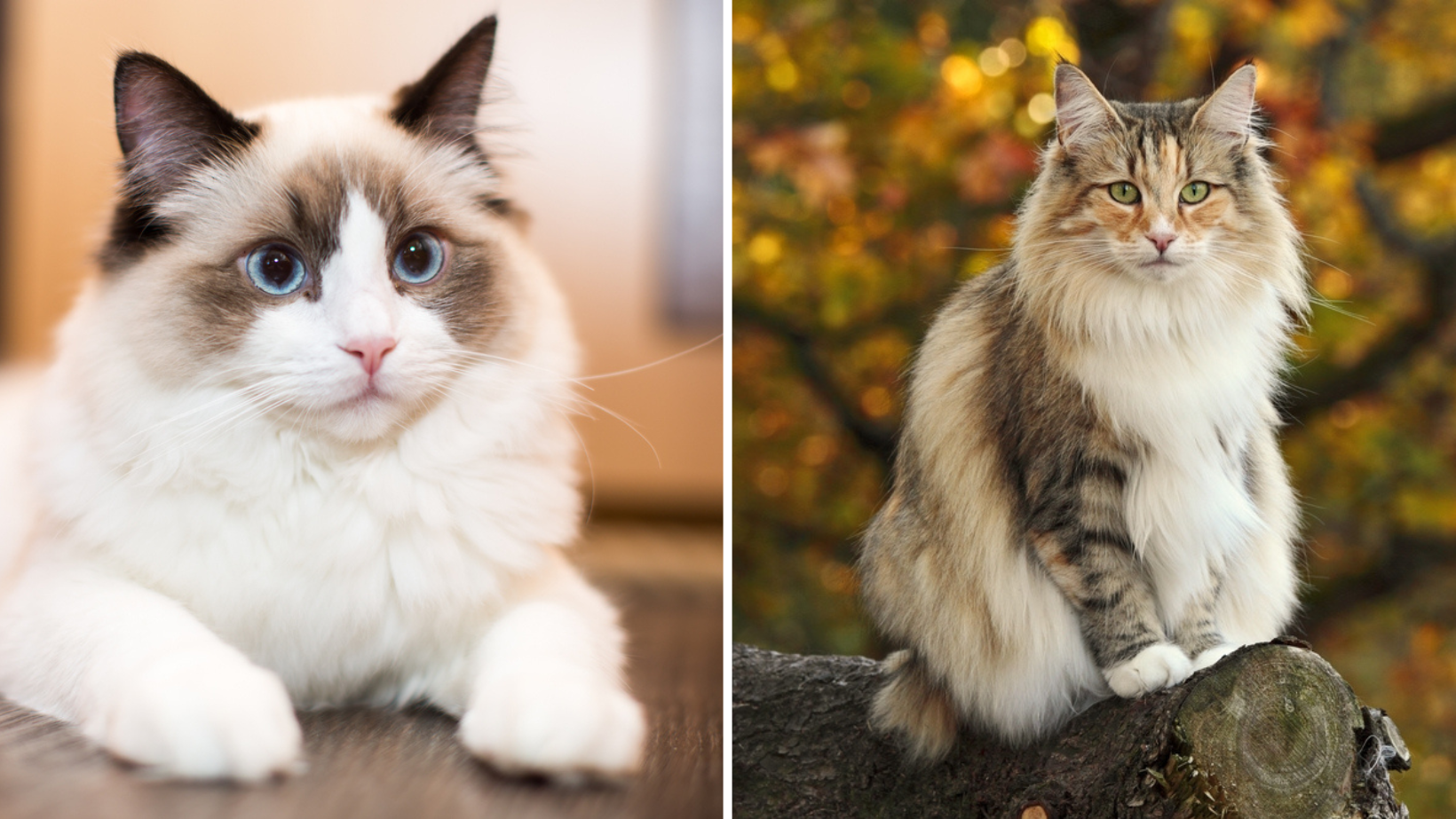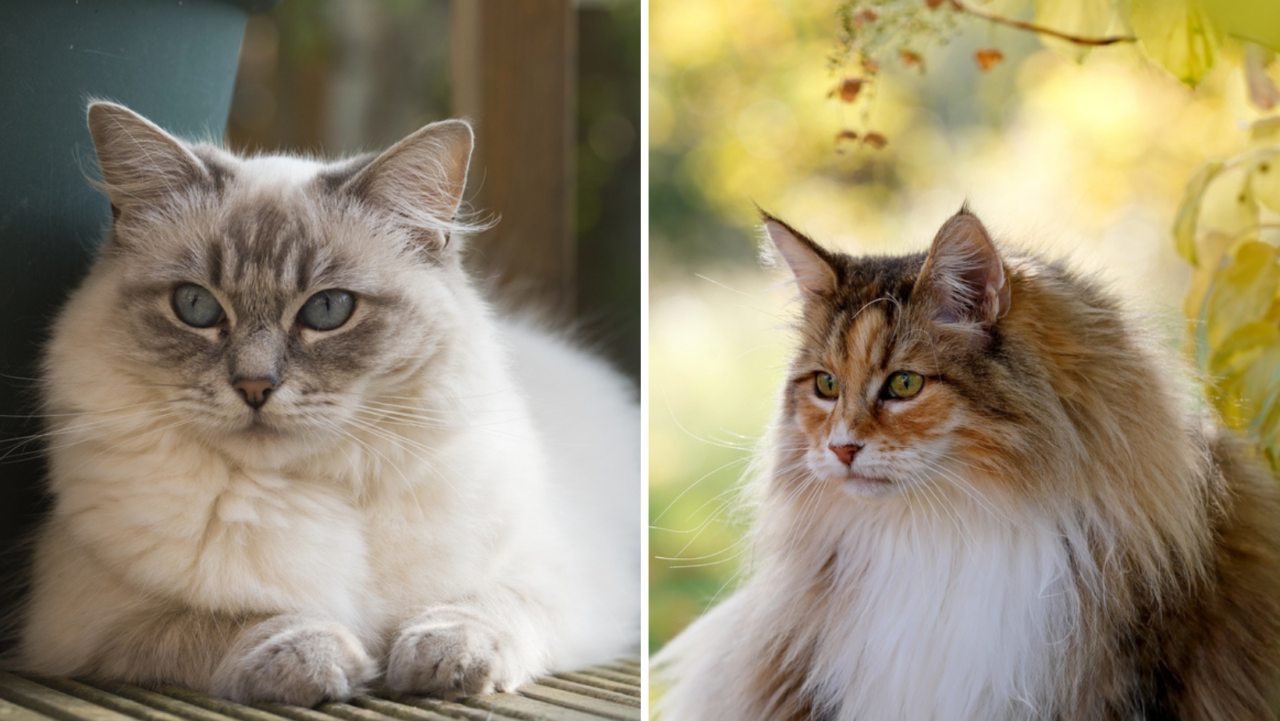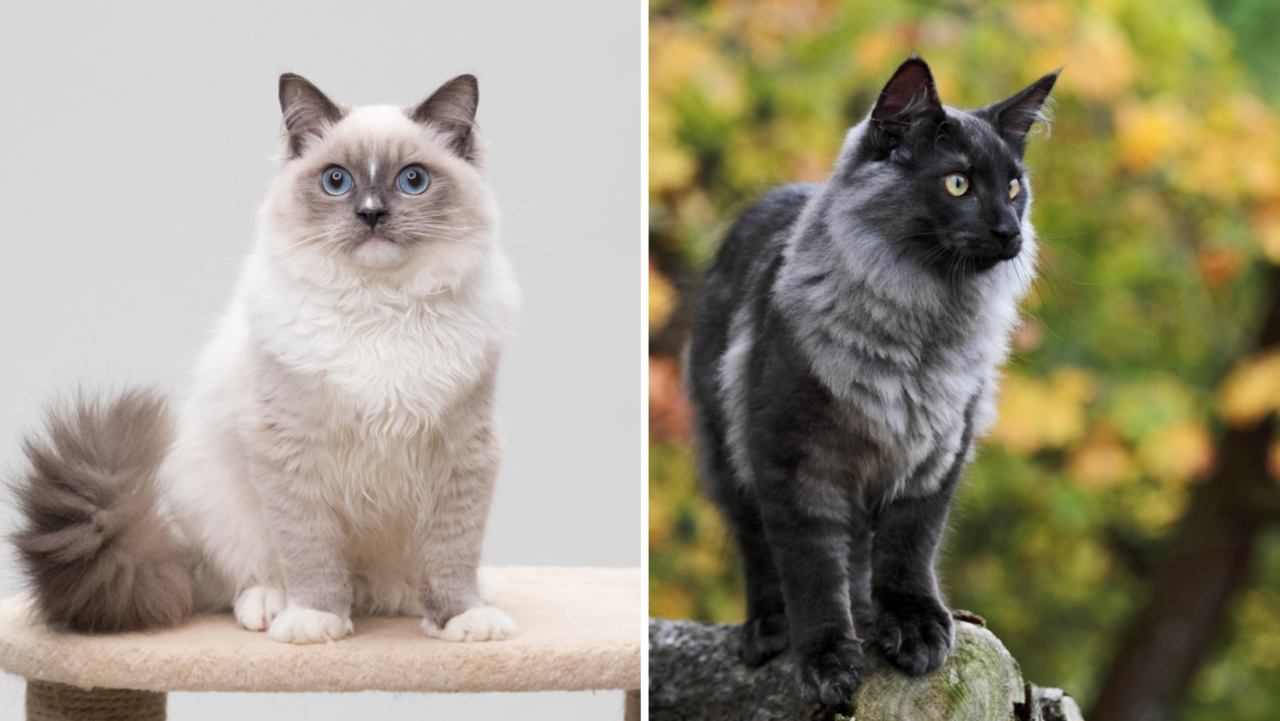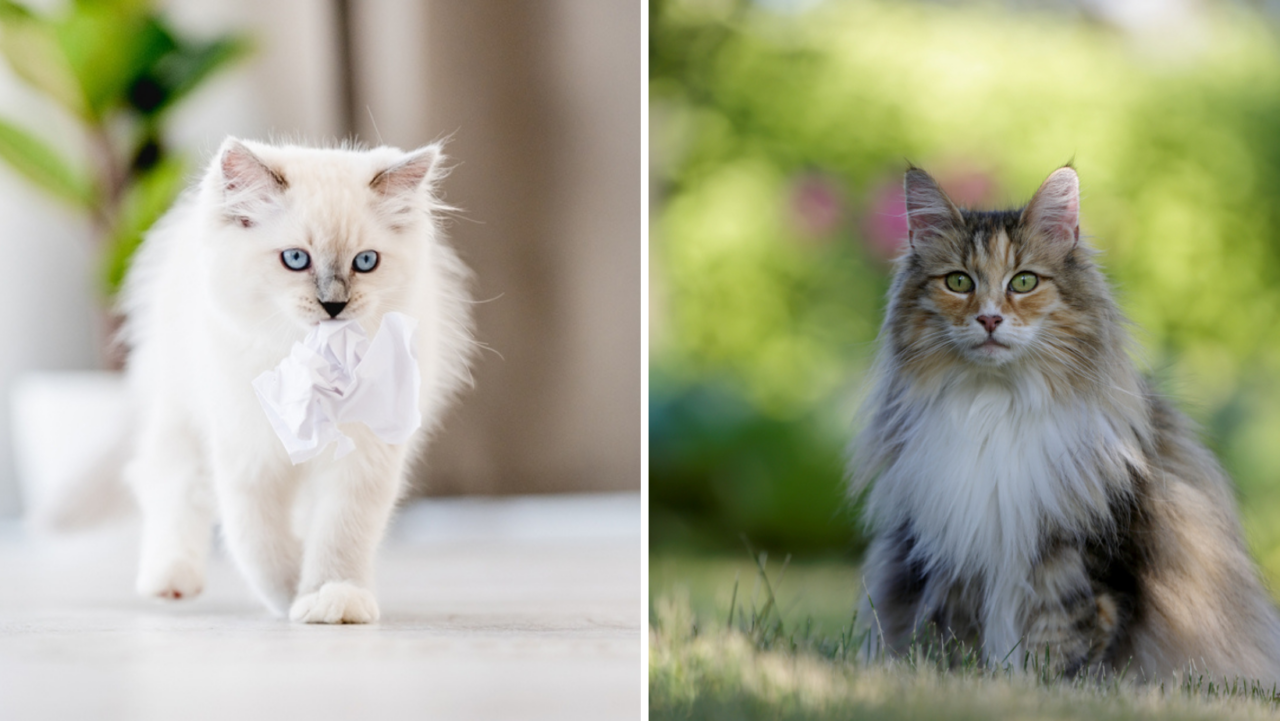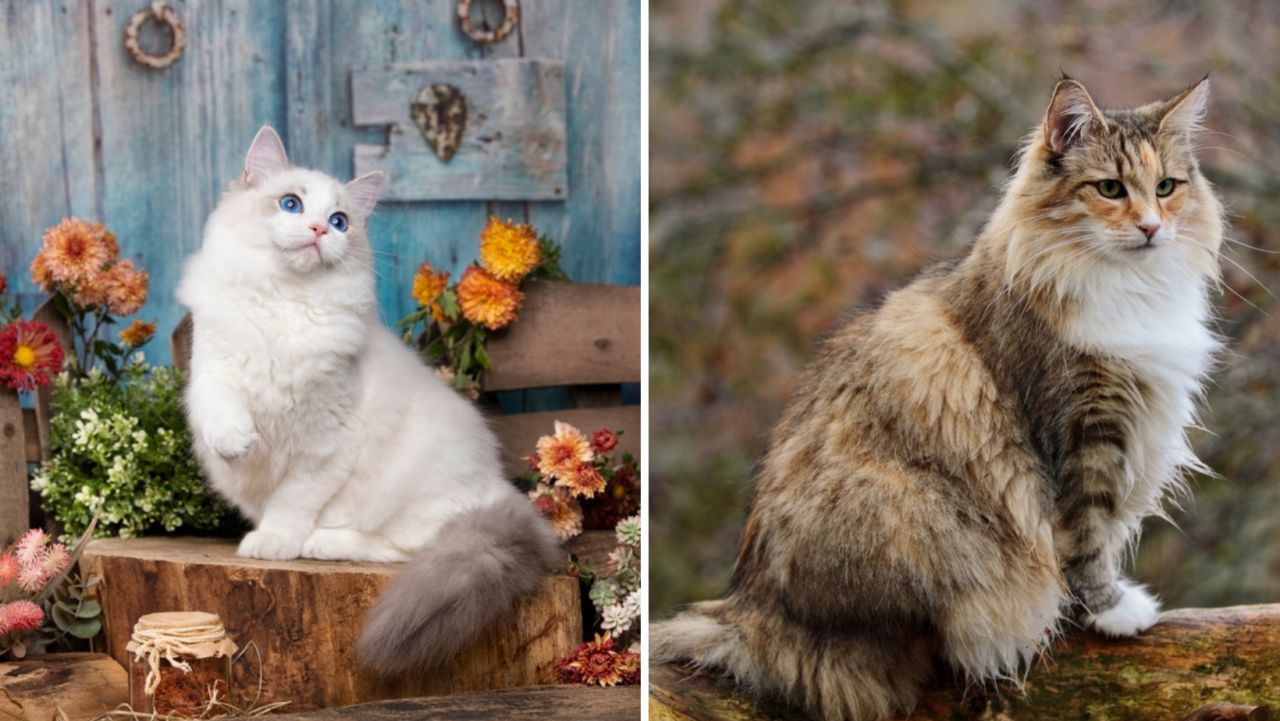📖 Table of Content:
Both are big, fluffy, and friendly, but still, there are some things that set them apart. Ragdoll vs. Norwegian Forest cat – which one is a perfect match for your household?
Having a cat is a precious experience filled with purrs and cuddles. No matter how rough a day you had, as soon as you walk through the door and hear your cat’s meow greetings, you instantly feel better.
Our furry friends heal us in ways we can’t even imagine. Cat parents around the world can attest that the moment you decide to get a pet, your life changes for the better.
But deciding which feline to get isn’t as simple. You need a kitty that can accommodate your lifestyle and household. You don’t want to adopt (or buy) a cat only to realize that you two could never work. That’s a heartbreaking feeling for both of you.
You have your eyes on two different breeds, so how do you make a final decision? Ragdoll vs. Norwegian Forest cat – which one of these is the right choice for you? Let’s help you find out!
Ragdoll vs. Norwegian Forest cat: What sets them apart?
When it comes to their looks, you can’t go wrong with either of these breeds. But owning a cat is much more than appreciating her beauty.
You need to take a few things into consideration, from her temperament to her health issues and grooming habits. They are all important factors that may affect your decision.
You’re going to spend a lot of upcoming years sharing a home with this furry monster. So, you want to make sure that both of you feel comfortable and happy in that environment. You and your cat deserve it.
If you’re torn between getting a Ragdoll or a Norwegian Forest cat, then we’re more than happy to help you. We can’t decide for you, of course, but we can let you know all about the differences and similarities between these breeds.
By the end of this article, you should be able to conclude which kitto will adjust better to your lifestyle.
1. Appearance
When it comes to their height, both of these cats are big. Adult Ragdolls reach 9 to 11 inches, while Norwegian Forest cats reach 9 to 12 inches.
Ragdolls can get a bit heavier, since they usually weigh 10 to 20 pounds, while Wegies tend to weigh 10 to 15 pounds. All in all, there’s not much difference, as both breeds are fairly chunky.
When you look at a Ragdoll cat, you’ll spot a short cat with thicker legs and a wider face. They have a really thick coat that makes them look all fluffy and maybe even chubbier than they actually are.
Norwegian Forest cats on the other hand don’t look as chonky due to their muscular legs. They also sport long fur that once kept them warm and protected in the cold Norwegian forests.
When it comes to coat coloration, Ragdolls have darker-colored fur on their heads, paws, and tails. Wegies don’t have any specific color details. However, they do come in more than 60 shades.
2. Behavior
Ragdolls are sweet and friendly and act like they have no care in the world. These furballs will approach you, sit down on your lap, and won’t leave the spot for hours. They love cuddling and they go all limp once you hold them in your arms.
They also get really close with their owner and will demand attention and love from you every day. This makes them great family pets since they’re going to enjoy all the cuddles and gentle scrubs on the back. If you have a full house, you don’t need to worry. These fluffy friends will get along with everyone just fine, kids included.
Even though we’re talking about a relaxed cat who enjoys lap cuddles, this breed is still up for play. Ragdolls love playing with different toys and they will especially enjoy playing with the rest of the family. These felines are precious furry gems that will make you fall in love with them within seconds.
Norwegian Forest cats are also friendly and gentle and will get along well with any family. They’re good with kids and don’t mind the noise they can produce.
Even though they’re an affectionate breed, Norwegian Forest cats still aren’t as needy as Ragdolls. They don’t enjoy cuddles as much and will occasionally jump into your lap for a few pats on the back. After that, they’re gone, looking for something to entertain themselves.
These felines are independent and don’t need your constant attention. Unlike Ragdolls, they won’t want to be the main character in your household.
Once they feel the need to be alone, they will slowly walk their way to their bed or a quiet space in the house. These cats resemble introverts who need some time to recharge their batteries after hanging out with too many people.
This breed is also a bit more active than a Ragdoll. They used to hunt in Norwegian forests, which explains their love for prey-like toys. They will play with them for hours and won’t get tired.
Wegies also love climbing, so getting them a cat tree or cat shelves is sure to make them happy. They’ll love exploring their surroundings from another perspective.
3. Attachment style
Based on their behavior patterns, you can already conclude how attached both of these breeds can get. Ragdolls are known to be more needy and require more attention from their owner. Norwegian Forest cats, on the other hand, will approach you when they feel like it, but won’t spend much time with you.
Ragdolls are also prone to separation anxiety if often left alone. They’re the ones to be waiting for you at the door, nervously expecting your comeback.
Norwegian Forest cats are more independent and won’t crave your attention 24/7. They can also develop separation anxiety, but it doesn’t happen as often as with Ragdolls.
4. Grooming habits
Both of these breeds have thick fur, so you can already imagine that it will take you a lot of time to keep it in tip-top shape. In this case, Norwegian Forest cats will require a bit more attention since they shed much more, especially as they transition from winter to summer coats.
Bear in mind that Wegies have an undercoat that needs to be combed and brushed. On top of that, they have a top coat that is water-repellent and also requires regular brushing. So, if you opt for this breed, you’ll be brushing your precious purrer at least twice a week. This is important for preventing matting and tangling, which can be extremely painful.
Ragdolls also have long fur, but they don’t have a thick undercoat. So, brushing them is generally easier and less time-consuming. Still, it needs to be done at least twice a week if you want to have a happy and mat-free kitty.
5. Health concerns
Different feline breeds are prone to different diseases. When it comes to Ragdolls, they can suffer from health issues such as hypertrophic cardiomyopathy, feline infectious peritonitis (FIP), and cryptococcosis.
Hypertrophic cardiomyopathy is a heart disease where the walls of your cat’s heart thicken and decrease her heart’s efficiency. This is a common issue among cats, and the only way to prevent it is to get your pet from a reputable breeder who has done all the testing.
FIP is a viral disease that’s really hard to diagnose. It transfers by sharing a litter tray with an infected cat, so the best way to prevent it is to pay attention to hygiene and ensure that you’re not overcrowding your cats.
Cryptococcosis is a fungal infection that develops by inhaling infectious spores of certain fungi. It can be treated, but it can take months before your cat gets back to her usual self.
Now, when it comes to Norwegian Forest cats, they’re also prone to hypertrophic cardiomyopathy. They can also develop hip dysplasia, which can’t really be treated. The best you can do is ensure you’re getting your feline from a reputable breeder who will provide you with info about the cat parents’ hip rating.
Both of these felines can also develop obesity. The best way to prevent this is to keep them active and not overfeed them.
Ragdoll vs. Norwegian Forest cat: Which one to get?
Now you have all the information you need about both of these breeds. From this point on, you’re on your own, as no one can make this decision for you.
When getting a pet, it’s important to consider your lifestyle and expectations. If you’re looking for a cuddly kitty, then Ragdoll is a good choice. On the other hand, if you’ll be happy with an affectionate cat that is also independent at the same time, then the Norwegian Forest cat is made for you.
It all comes down to your personal preferences and your ability to offer the life these purrers deserve.
